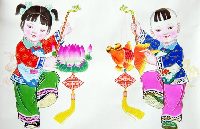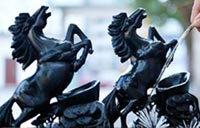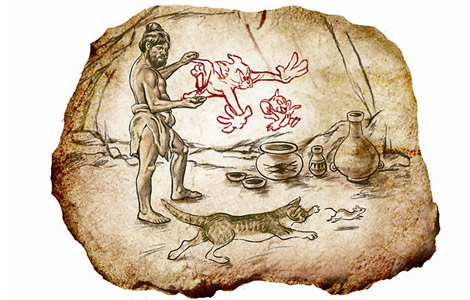Calligraphy draws life from ink-oil tension
Updated: 2014-01-30 07:37
By China Daily in New York (China Daily)
|
|||||||||||
 |
| Portraits of fortune |
 |
| Louvre wonders come to China |
 |
| Horse theme a hit with artists |
The calligraphy demonstration took place at the opening of a new exhibition, entitled Guanshan Gathering, which runs through Feb 22. The show features collaborative works by Chinese scholar, curator and artist Zheng Shengtian and acclaimed Chinese calligrapher Wang Dongling.
"The two materials (water-based ink and oil canvas) work against each other, which is why when you write on the canvas, the effect will be drastically different from what normal Chinese calligraphy looks like," says Zheng, who is behind the idea of using the two conflicting materials.
"The process resembles the conflicts and misunderstandings that often occur in communication between human beings, a clash and blend between the East and the West," he adds.
To show the varied meanings between different languages and interpretations, the gallery provided three translations of the written text in the demonstration - from a Buddhist, a poet and Google Translate.
"It is a traditional Chinese calligraphy with a new touch of modern age, a kind of joint venture of the East and the West," says J. D. Hotchkiss, an art representative and frequent visitor to the gallery. "It is very good and I like to see Chinese calligraphy being brought to the West."
"I think it's a unique opportunity for the New York art world to see a calligrapher," says Stephanie Mar, a visual artist and textile designer. "I have definitely got inspired."
The idea of writing with ink on an oil canvas was developed 13 years ago, Zheng says, when he was invited to create an installation for the Word and Meaning: Six Contemporary Chinese Artists at the State University of New York at Buffalo. Back then his wife Aikang wrote Clement Greenberg's essay Modernist Painting in ink on four oil canvases, accompanied by an audio recording of Canadian artist Hank Bull reading the essay.
Much like the work in Guanshan Gathering, the ink shrank until only random black dots remained on a sheer trace of the written characters, reminiscent of an abstract painting. Zheng recorded the entire process to show the theme of conflict and transformation.
Years later an invitation from Chambers Fine Arts inspired Zheng to conduct a new interpretation of the ink-versus-oil-canvas idea, as the previous work was a bit rushed, Zheng says.
"This time I invited my old friend, the most prominent Chinese calligrapher Wang Dongling, to collaborate on the work, and this would be a challenge for him too as a calligrapher because he had never drawn on a material that he was unfamiliar with," he says.
The team chose the 5th-century classic Introduction to Landscape Painting by Zong Bing, a Southern Dynasty (AD 420-589) painter, as the text for their first set of artworks completed in Hangzhou. The work was well received in the exhibition in Beijing last summer. However, due to space limitations, it could not be shown in New York.
Zhang Yang contributed to this story.
Related Stories
Brush with the past: Spring Festival calligraphy 2014-01-27 11:11
Expat paints horse for Lunar New Year 2014-01-27 10:58
Zhang Daqian's work exhibited in Beijing 2014-01-21 10:14
Artist preserves old styles through painting and calligraphy 2014-01-15 16:02
Bangshu art in Suzhou 2014-01-10 11:23
Today's Top News
London goes all-out to ring in Lunar New Year
Chinese family infected with H7N9
HK imposes sanction on Philippines
More Chinese set to travel overseas
Experts call for detailed H7N9 rules
Huawei pledges more jobs in Europe
HK confirms H7N9 case, to cull 20,000 poultry
Chinese President to visit Paris to boost ties
Hot Topics
Lunar probe , China growth forecasts, Emission rules get tougher, China seen through 'colored lens', International board,
Editor's Picks

|

|

|

|

|

|





